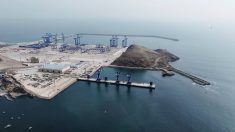The big difference is that China is more reliant on Canadian canola than it was on barley shipments from Australia
SASKATOON — Canada’s canola growers could learn something from Australia’s barley farmers when it comes to the latest potential trade barrier with China.
China’s Ministry of Commerce announced Sept. 3 that it is initiating an anti-dumping investigation into canola seed imports from Canada.
Related stories:
The case is reminiscent of Nov. 19, 2018, when China initiated an anti-dumping investigation into Australian barley.
Read Also

Russian wheat exports start to pick up the pace
Russia has had a slow start for its 2025-26 wheat export program, but the pace is starting to pick up and that is a bearish factor for prices.
LeftField Commodity Research analyst Chuck Penner said the Australia case is probably a good parallel for Canada, although there are some differences.
In Australia, the anti-dumping investigation announcement was followed one month later by a countervailing duty investigation announcement.
Australian exporters and grain industry bodies provided their responses to both investigations in February 2019.
It took 18 months from the initial announcement for China to impose duties of 80.5 per cent on all barley imported from Australia on May 19, 2020.
Australia initiated a complaint with the World Trade Organization on Dec. 16, 2020.
The WTO’s Dispute Settlement Body established a panel at the behest of Australia on May 28, 2021.
The panel issued its final report to the parties on March 15, 2023.
Less than one month later, on April 11, 2023, China and Australia requested the panel suspend its work because the two parties had worked together on a solution.
Those discussions resulted in China removing its 80.5 per cent duty on Australian barley on Aug. 5, 2023, more than three years after it was implemented.
The duties effectively blocked exports to a market that was worth US$615 million annually to Australian farmers before the trade dispute.
China accounted for 50 to 75 per cent of Australia’s barley exports prior to the tariffs.
Exports to China peaked at 6.3 million tonnes in 2016-17 before falling to negligible levels once the duties were imposed.
Exports rebounded to 2.94 million tonnes in 2023 and already topped that volume in the first half of 2024 with 2.97 million tonnes of sales to China.
China purchased 4.59 million tonnes of Canadian canola in 2023, which represented 65 per cent of total sales that year.
Sales through the first six months of 2024 totaled 2.74 million tonnes.
That is a big rebound following four straight years where exports to China averaged 2.14 million tonnes.
Sales during those years were about half their normal volumes because China suspended the export licences of Richardson International and Viterra in response to Canada’s detention of Huawei chief financial officer Meng Wanzhou.
Penner said all exporters of Canadian canola could be affected by potential Chinese tariffs this time around.
“In this case it will probably be more of a broad-brush kind of a thing,” he said.
Penner wonders why China would go to such extremes because it needs canola and Canada is by far the largest global provider of that commodity.
In that way, the Canada situation is dissimilar to the Australian barley tariff incident.
“In that case there were other countries that could step in and provide barley to China,” he said.
“In this case there’s limited other options.”
















